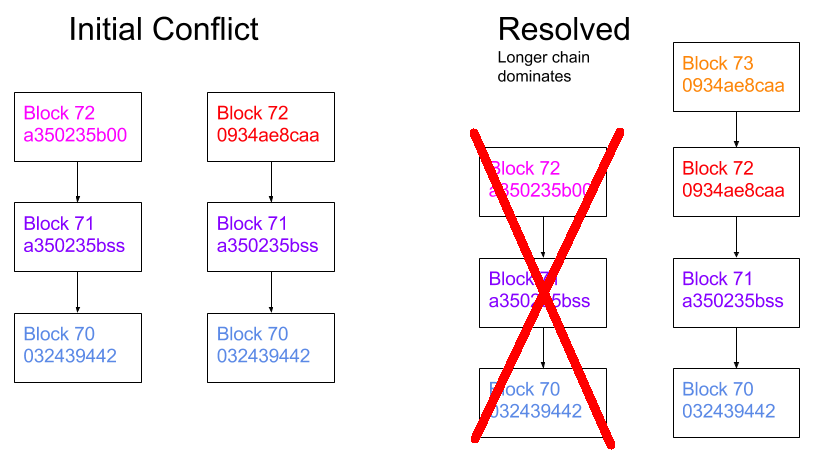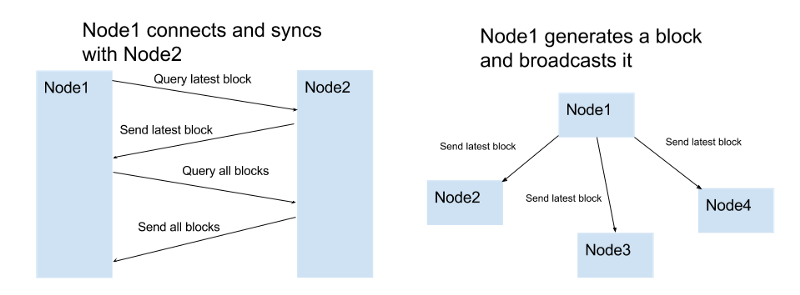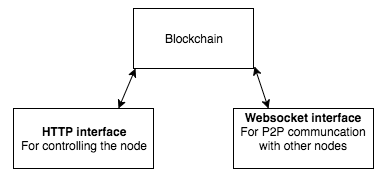Blockchain 200 lines of code
The basic concept of the blockchain is quite simple: a distributed database that maintains an ever-growing list of ordered records.
However, many things remain incomprehensible when we talk about the blockchain, there are also many problems that we are trying to solve with its help. This also applies to popular blockchain projects such as Bitcoin (Bitcoin) and Ethereum (Ethereum). The term “blockchain” is usually strongly linked to concepts such as money transfers, smart contracts, or cryptocurrencies.
This makes understanding the blockchain more difficult than it actually is. Especially the source code. Here I will go through a super-simple blockchain implementation of 200 lines of JavaScript code called NaiveChain.
')
The first logical step is to determine the structure of the block. To keep everything as simple as possible, we included only the most necessary: index, mark, data, hash, and hash of the previous block.

The hash of the previous block must be found in the block to preserve the integrity of the circuit.
The block must be hashed to preserve data integrity. SHA256 is responsible for the content of the block. It should be noted that this hash has nothing to do with the mining, since there is no confirmation of the work - solving the problem.
To create a block, you need to know the hash of the previous block, and the rest must be created as follows (= index, hash, data, and timestamp). The date block is some information that is passed to the end user.
In memory, a JavaScript array is used to store the blockchain. The first blockchain block is always the so-called “genesis block”, which has the following code:
At any time, we should be able to check whether a block or chain of blocks is valid from the point of view of integrity. This is especially true when we receive new blocks from other nodes and must decide whether to accept them or not.
There should always be only one explicit set of blocks in a chain at a time. In the event of a conflict (for example, two nodes as in the created block number 72), we choose a circuit that has the longest row of blocks.

Communicating with other nodes
An important function of a node is the separation and synchronization of the blockchain with other nodes. Rules - used to maintain network synchronization:

Some typical communication scenarios that follow when nodes comply with the described protocol
There is no automatic mutual detection. Locations (= URLs) parties must be added manually.
The user, in some way, should be able to control the node. This is done by configuring the http server.
As you can see, the user can interact with the node in the following ways:
The easiest way to manage a node - for example, using Curl:
It should be noted that the host actually provides two web servers: one for the user to control the host (http server) and one for peer-to-peer communication between the hosts. (Websocket http server)

Main components of NaiveChain
NaiveChain was created for demonstration and training purposes. As long as he does not have a mining algorithm for (PoS of PoW), it cannot be used in a public network. Nevertheless, it implements the basic functions for the blockchain implementation.
However, many things remain incomprehensible when we talk about the blockchain, there are also many problems that we are trying to solve with its help. This also applies to popular blockchain projects such as Bitcoin (Bitcoin) and Ethereum (Ethereum). The term “blockchain” is usually strongly linked to concepts such as money transfers, smart contracts, or cryptocurrencies.
This makes understanding the blockchain more difficult than it actually is. Especially the source code. Here I will go through a super-simple blockchain implementation of 200 lines of JavaScript code called NaiveChain.
')
Block structure
The first logical step is to determine the structure of the block. To keep everything as simple as possible, we included only the most necessary: index, mark, data, hash, and hash of the previous block.

The hash of the previous block must be found in the block to preserve the integrity of the circuit.
class Block { constructor(index, previousHash, timestamp, data, hash) { this.index = index; this.previousHash = previousHash.toString(); this.timestamp = timestamp; this.data = data; this.hash = hash.toString(); } } Block hash
The block must be hashed to preserve data integrity. SHA256 is responsible for the content of the block. It should be noted that this hash has nothing to do with the mining, since there is no confirmation of the work - solving the problem.
var calculateHash = (index, previousHash, timestamp, data) => { return CryptoJS.SHA256(index + previousHash + timestamp + data).toString(); }; Block generation
To create a block, you need to know the hash of the previous block, and the rest must be created as follows (= index, hash, data, and timestamp). The date block is some information that is passed to the end user.
var generateNextBlock = (blockData) => { var previousBlock = getLatestBlock(); var nextIndex = previousBlock.index + 1; var nextTimestamp = new Date().getTime() / 1000; var nextHash = calculateHash(nextIndex, previousBlock.hash, nextTimestamp, blockData); return new Block(nextIndex, previousBlock.hash, nextTimestamp, blockData, nextHash); }; Block storage
In memory, a JavaScript array is used to store the blockchain. The first blockchain block is always the so-called “genesis block”, which has the following code:
var getGenesisBlock = () => { return new Block(0, "0", 1465154705, "my genesis block!!", "816534932c2b7154836da6afc367695e6337db8a921823784c14378abed4f7d7"); }; var blockchain = [getGenesisBlock()]; Check the integrity of the blocks
At any time, we should be able to check whether a block or chain of blocks is valid from the point of view of integrity. This is especially true when we receive new blocks from other nodes and must decide whether to accept them or not.
var isValidNewBlock = (newBlock, previousBlock) => { if (previousBlock.index + 1 !== newBlock.index) { console.log('invalid index'); return false; } else if (previousBlock.hash !== newBlock.previousHash) { console.log('invalid previoushash'); return false; } else if (calculateHashForBlock(newBlock) !== newBlock.hash) { console.log('invalid hash: ' + calculateHashForBlock(newBlock) + ' ' + newBlock.hash); return false; } return true; }; Choose the longest chain
There should always be only one explicit set of blocks in a chain at a time. In the event of a conflict (for example, two nodes as in the created block number 72), we choose a circuit that has the longest row of blocks.

var replaceChain = (newBlocks) => { if (isValidChain(newBlocks) && newBlocks.length > blockchain.length) { console.log('Received blockchain is valid. Replacing current blockchain with received blockchain'); blockchain = newBlocks; broadcast(responseLatestMsg()); } else { console.log('Received blockchain invalid'); } }; Communicating with other nodes
An important function of a node is the separation and synchronization of the blockchain with other nodes. Rules - used to maintain network synchronization:
- When a node generates a new block, it broadcasts it to the network.
- When a node connects to a new peer-to-peer network, it relies on the last block
- When a node detects a block that has an index larger than the current known block, it either adds the block in its current state to its own chain or supports it to populate the blockchain.

Some typical communication scenarios that follow when nodes comply with the described protocol
There is no automatic mutual detection. Locations (= URLs) parties must be added manually.
Node control
The user, in some way, should be able to control the node. This is done by configuring the http server.
var initHttpServer = () => { var app = express(); app.use(bodyParser.json()); app.get('/blocks', (req, res) => res.send(JSON.stringify(blockchain))); app.post('/mineBlock', (req, res) => { var newBlock = generateNextBlock(req.body.data); addBlock(newBlock); broadcast(responseLatestMsg()); console.log('block added: ' + JSON.stringify(newBlock)); res.send(); }); app.get('/peers', (req, res) => { res.send(sockets.map(s => s._socket.remoteAddress + ':' + s._socket.remotePort)); }); app.post('/addPeer', (req, res) => { connectToPeers([req.body.peer]); res.send(); }); app.listen(http_port, () => console.log('Listening http on port: ' + http_port)); }; As you can see, the user can interact with the node in the following ways:
- View a list of all blocks
- Create a new block with user-defined content.
- View or add peer users
The easiest way to manage a node - for example, using Curl:
#
curl http://localhost:3001/blocksArchitecture
It should be noted that the host actually provides two web servers: one for the user to control the host (http server) and one for peer-to-peer communication between the hosts. (Websocket http server)

Main components of NaiveChain
Conclusion
NaiveChain was created for demonstration and training purposes. As long as he does not have a mining algorithm for (PoS of PoW), it cannot be used in a public network. Nevertheless, it implements the basic functions for the blockchain implementation.
Source: https://habr.com/ru/post/323586/
All Articles